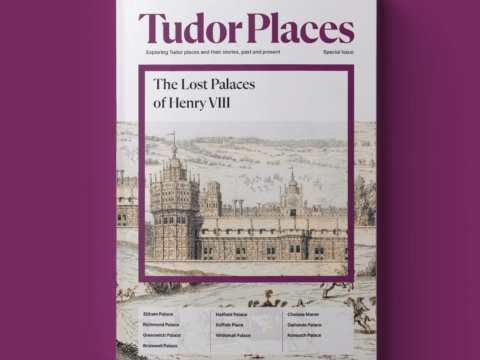Who's Who in Shakespeare's Henry VIII
A Guide to the Personalities in the Play
Chapter 7 : Warham - Wrythe
Warham, William, Archbishop of Canterbury c. 1450 – 1532 Warham is not named in the play, merely appearing as one of the attendees at the Legatine Court at Blackfriars
Warham was the Archbishop of Canterbury who immediately preceded Cranmer. Initially trained as a lawyer, he became Master of the Rolls in 1494. He undertook a number of diplomatic and trade missions for Henry VII, including the negotiations for the marriage of Prince Arthur to Katharine of Aragon. By 1504, Warham was Lord Chancellor and Archbishop of Canterbury. Following Henry VIII’s accession in 1509, he was seen as a member of the old guard, promoting peace with France rather than supporting Henry VIII’s warlike ambitions. He resigned the Chancellorship to Wolsey in 1515. When the King’s annulment suit began, he was assigned as legal counsel to Queen Katharine, but, intimidated by the thought of angering the King, gave her little support and urged the Pope to accede to Henry’s wishes. Warham accepted Henry VIII as Supreme Head of the Church in England, and assented to the large fine levied on the Clergy. In the last year of his life, he protested more vigorously against Henry’s religious policies, but to little avail.
Bishop of Ely, Nicholas West 1461 – 1533 A non-speaking attendee of the Legatine Court in the play, Ely was one of Henry VIII’s chaplains. In life, he deposed that he believed the marriage between Arthur and Katharine had not been consummated. He was also an important diplomat, undertaking many missions to Scotland, particularly in the years after 1513, when the minority of James V made for a troubled relationship between the countries. He spent enormous sums on beautifying Ely Cathedral and building a chantry chapel there, the decoration of which fell prey to the iconoclasm of Edward VI’s reign.
Wolsey, Thomas, Cardinal and Archbishop of York c. 1470 – 1531 To an extent, Wolsey is the villain of the play – eaten up with ambition, he sows dissension amongst Henry’s nobility, and poisons the King’s mind against Queen Katharine, who remonstrates with him over his treatment of Buckingham. Nevertheless, after he is disgraced (the King is shown a letter from Wolsey to the Pope, asking him to delay judgement in the annulment) he is redeemed with true repentance for his former ambition.
Wolsey was (probably) the son of an Ipswich grazier. Exceptionally intelligent, he graduated from Magdalen College, Oxford, aged just fifteen and was ordained priest in 1498. He entered the service of Henry VII in 1507 as Royal Chaplain, and secretary to Bishop Foxe, Lord Privy Seal. Wolsey was appointed Almoner to Henry VIII in 1509 and began a rapid climb to power, following Bainbridge as Archbishop of York from 1514.
Cardinal.Wolsey was not just Henry VIII’s Lord Chancellor, he had a warm personal relationship with the King, although he was never popular with Queen Katharine or the members of the nobility who considered him arrogant and proud. Wolsey lived in spectacular style, creating the masterpiece Hampton Court from a small manor house. He was an important figure in European politics, working with Henry to maintain a foreign policy that would enhance the prestige of England with the other European princes. His finest moment was probably the organisation of the Field of Cloth of Gold.
Wolsey was tolerant in religious matters, and tried to institute some measures of reform in the Church. He also instituted the suppression of some monasteries to divert funds to his great Oxford College. Wolsey had a vast entourage of priests, lawyers, secretaries, and other hangers – on and Cromwell began working for him in the early 1520s. Wolsey’s failure to obtain an annulment of Henry’s first marriage, and the personal animosity of Anne Boleyn led to his catastrophic fall from power in 1529. Despite some dithering by Henry, who was fond of Wolsey, he never regained influence, and in 1531 was accused of treason, dying en-route to London.
Wootton (or Wotton), Margaret, Dowager Marchioness of Dorset 1487 – 1541 Margaret does not have a speaking part, but is shown in the coronation procession of Anne Boleyn, and later as godmother to Elizabeth. The Wotton family of Boughton Malherbe in Kent were higher ranking gentry, holding various administrative offices under Henry VIII. Margaret made an excellent marriage to Thomas Grey, 2nd Marquess of Dorset, the half-brother of Queen Elizabeth of York, and thus became aunt-by-marriage to Henry VIII. She was widowed whilst her son, Henry Grey (q.v.) was a minor, and kept him short of money, particularly after he had refused to marry the Earl of Arundel’s daughter and was obliged to pay a £4,000 fine. The King and many of the nobles thought her behaviour unbecoming, but, looking at her son’s later career, she may have spotted that he was not very competent. She was once identified as the sitter in Holbein’s Lady with the Squirrel, but the attribution is now questioned.
Wrythe or Wriothesley, Thomas, Garter King of Arms 1534 Not to be confused with the politician of the same name, his nephew. Garter’s role in the play, as in life, is to open the Legatine Court and lead the coronation procession of Anne Boleyn, and the christening procession of Elizabeth. Wrythe had early appointments as a Herald to the household first of Prince Arthur and then of Henry VIII when a prince. As the senior King of Arms, he presided over the arrangements for Henry VII’s funeral and the coronation of Henry and Katharine.




